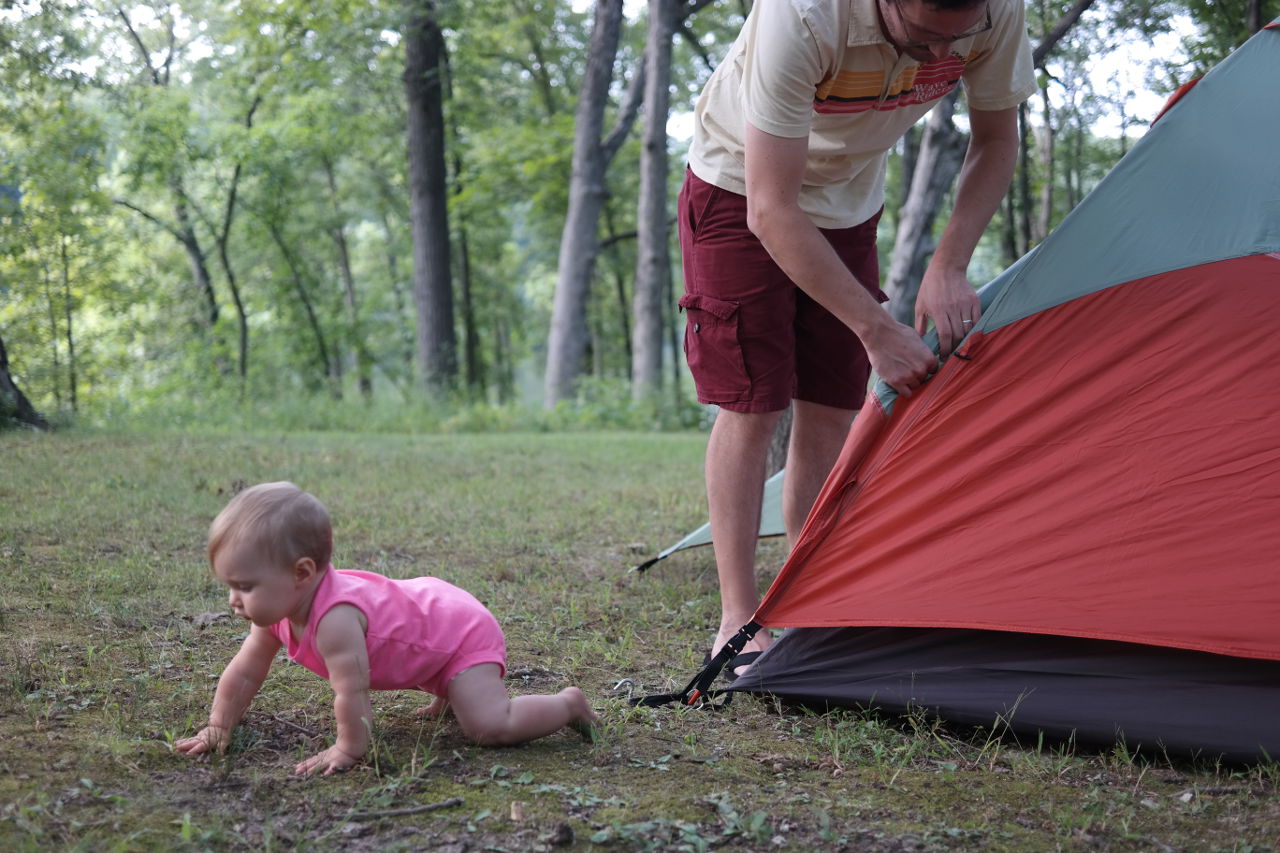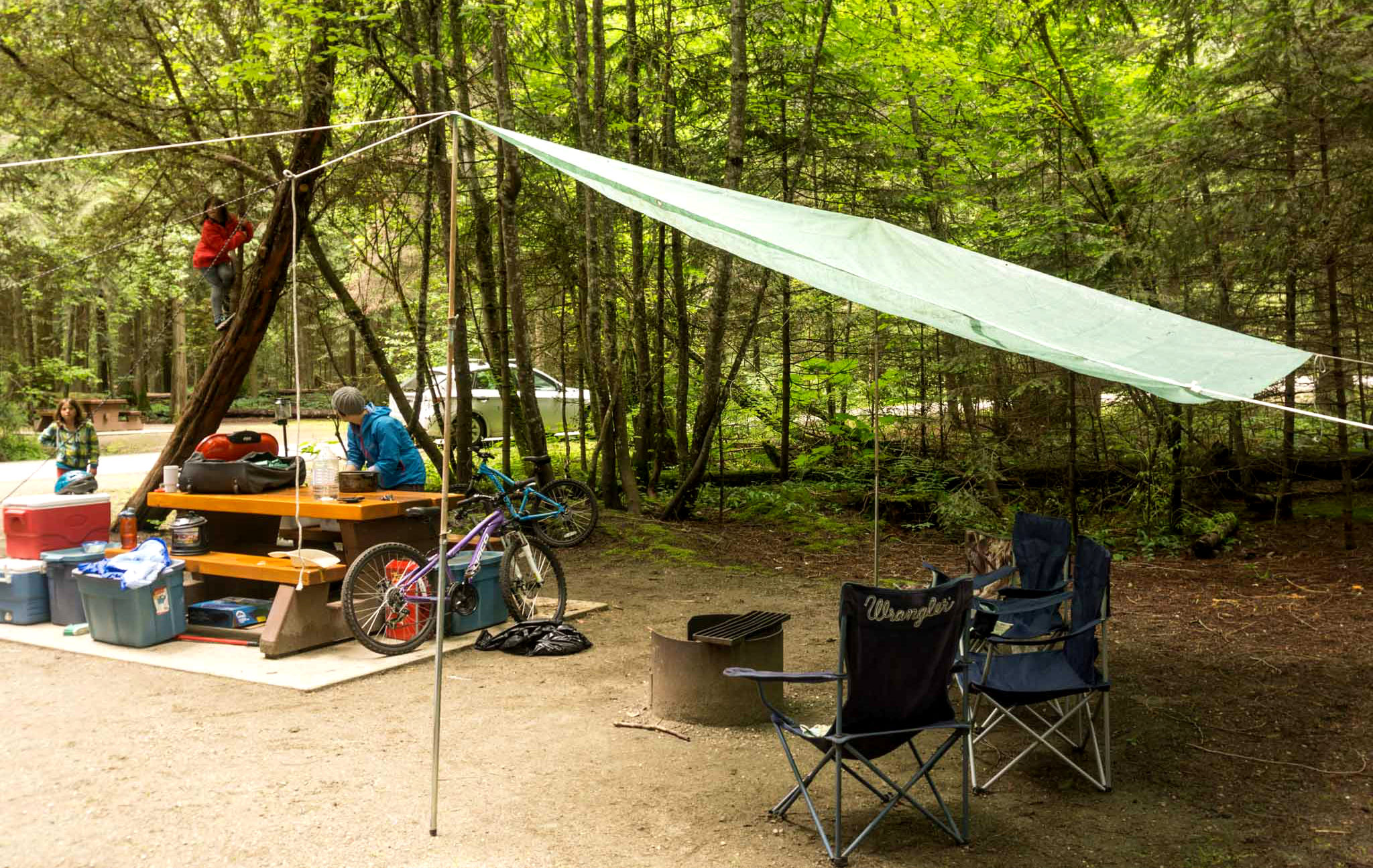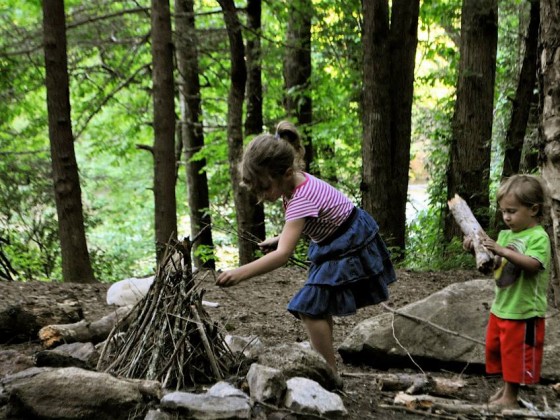THERE’S A POWERFUL SENSE of accomplishment that comes with being able to take your kids camping anywhere and have it feel like home. I recall six years ago, my family’s first camping trip. We’d taken my then 2-year-old daughter to a campground on the Elwha River on Washington’s Olympic Peninsula. As is always my camping habit, I awoke at dawn, made coffee, and then wandered across the road, down toward the river through a damp forest of Douglas fir.
Suddenly, some movement: Two, now three elk jumped up and then disappeared in the thick salmonberry. I examined the area and discovered the matted down places in the forest where they’d slept. Their “camp,” as it were, was less than 200 yards from where we’d set up for the night.
I walked back to the tent. Not hearing or seeing any movement, I looked through the mesh window. My daughter and her mom were still bundled in their bags, asleep, comfy. We’d passed this first night very peacefully. I stood for a few minutes then as the sun rose, just taking the scene in. All around was the temperate rainforest, huge conifers and big-leaf maple. Standing high above were the snowfields on the West Peak of Mt. Olympus. There was no wind; everything was silent and still except for the sound of the Elwha running through a small boulder garden nearby.
Everyone would soon be up and our day would begin, but I savored this quiet moment alone — the rare feeling of calling this patch of woods our home for the weekend.
My family has grown since then, and camping is up there among our favorite things to do together. Through all that time out in the woods (or in the desert, or on the beach), I’ve picked up some tips that help separate a really rewarding camp trip from a mediocre one, at least for my family. The following are nine things you should avoid when camping with kids. Take them less as rules and more like signposts leading you in a certain direction.
1. DON’T bring electronic devices for entertainment.

Photo: Hal Amen
Let’s go ahead and get this out of the way. The real benefit of camping is that feeling of stillness, clarity, awareness. You begin to really hear the river. The birdsong. You begin to notice things — the patch of moss turned golden in the morning sun. The slow steps of a great blue heron stalking through a shoal.
You settle into this new rhythm to the degree that you “unplug” from the overactive mind — part of which comes from constant screen-time. Games, apps, and electronic devices used as “distractions” — whether for the car ride or waiting at the restaurant — only detract from the experience.
And yet, presenting this in a punitive way (“No devices while we’re camping!”) will backfire. Instead, make it a team-like challenge that you include yourself in as well (“Dad needs a break from being on the phone and the computer”), and explain how it will be good for everyone: “Over the next few days, we’re going to start hearing better, seeing better — just wait until our night hikes — and part of the reason is we’re not going to have our eyes on screens.”
At the same time, you may still want to encourage the use of digital tools such as cameras — as long as the kids are staying creative and productive (perhaps you have a young filmmaker on your hands). Overall, it’s about not squandering the precious time you have together in the woods or beach or mountains.
2. DON’T set up gear for the first time there in the camp.
Setting up gear will inevitably be one of the most fun (and funny) parts of camping. But don’t miss the opportunity to build up the anticipation even more: Set up camp in the living room or backyard beforehand.
As you assemble the tent at home, give the kids certain jobs — perhaps they clip the tent body to the poles or help run the pole through the sleeves. Maybe they unroll the sleeping pads or spread out the bags. This can also be a good moment to go over a few tips, like not walking on the tent while it’s spread out on the ground or being careful with the poles.
Once everything is set up, let the kids play in it, use it as their fort for the day or even a sleeping spot for the night (especially for smaller children). Then, when you’re doing the real thing in the woods, there will be a sense of familiarity; the kids may already feel some ownership of their “tasks,” and most of all they’ll be stoked to get back to their fort.
3. DON’T carry in gear and set up camp yourself.
Whether you’re just walking a few camping boxes into the site from the car or backpacking, there’s a feeling of accomplishment hauling in your gear and getting it all set up. Make sure the whole family participates in this. It might take longer if you divvy these tasks up to your elementary-school-age “helpers” than just doing it yourself, but this is a fundamental part of the experience.
Make preparations beforehand for your kids to at least carry their own packs, possibly with their sleeping bags and/or sleeping pads. And once they’re around 7, consider having them be responsible for their own pack with all of their personal items, including headlamp, toothbrush, etc.
4. DON’T go without a “mission.”
For our family, camping always includes some kind of terrain “objective.” For example, in one of our favorite campgrounds, Big Creek in Great Smoky Mountains National Park, the objective is to hike up the trail to Midnight Hole.
Some places have obvious objectives, such as peaks to climb. But other places you have to use your imagination and be creative. The “mission,” especially for young kids, can be as simple as “making it down to the creek for a swim.” The important thing here is — as with the points above — being proactive in the way you build up anticipation for your adventure.
5. DON’T overplan or force it.
At the same time, it’s important to leave space in your planning for “just being out there.” Maybe you wanted to make it down to the creek, but it rained too much the week before and the banks are super muddy and the water itself is too dirty to play in. A huge part of camping is adapting to whatever conditions are at hand, not just forcing whatever itinerary you had in mind.
6. DON’T have a tent as your only shelter.

Photo: Carlo Alcos
Another key aspect of camping is simply being gathered together as a family in a small space. It’s really important, then, to consider your “central meeting space.” Oftentimes people focus only on tents and neglect to construct a central shelter for the group. A simple tarp setup like the one above can work very well; pre-made tarp shelters like the REI Alcove Shelter are good too. You don’t want your only dry area to be your tent — that gets cramped fast.
7. DON’T fail to bring (or even create) crafts/toys.
As with deploying the camp itself, part of the joy of camping is being able to play with toys or ride crafts you don’t typically get to use. Since our local terrain is Southern Appalachia, we’re typically camping by rivers. Even though I may not actually be on a kayaking mission, I’ll often still bring my playboat (there’s usually a fun wave or eddyline nearby) as well as a small inflatable craft for the kids and me to play with in the eddies. This becomes a loose part of our “mission” and yet something we don’t have to force. We break out the watercraft if the conditions call for it, but there’s no pressure.
And sometimes it doesn’t even take having the crafts or toys; sometimes it’s just about imagination. Some of our happiest camping moments have been purely spontaneous. At a small tumbling creek we suddenly began having “6-inch boater races,” each of us taking turns breaking up sticks or pieces of driftwood and throwing them in as “mini-boaters.”
Other games you can invent on the spot: “rock golf” (choose a “hole” — a nearby stump or boulder — then play “golf” using rocks), hide and seek, “mini-city” (building shelters for the kids’ dolls).
8. DON’T go small on the food.
Food always tastes better when you’re camping, and meals shared around the fire have a way of staying in your memory. It might seem like camping meals take extra effort, but as with everything else it’s really about imagination. Three fundamental pieces of gear to bring along are a stove, cutting board(s), and table. Make sure you have a camp stove that can simmer/cook on low heat, such as the Coleman Dual-Fuel 2 Burner Stove. This is key for pancakes and cooking rice. An extra cutting board (even an extra frisbee can work) for passing along to one of your helpers is also key.
Meal prep is also much easier if you have a table. Most established campsites will have picnic tables; if you’re taking your crew into the backcountry, consider bringing something like the REI Camp Roll Table. Finally, don’t rely too heavily on prepackaged backpacking meals. These can be great for stormy days when you just need to get food and dishes done quickly, but in general, take the opportunity of family camping to involve everyone in the meal prep. Let one of the kids use the extra cutting board and an appropriate knife and help chop vegetables.
My go-to crowd-pleaser dinner — an old-school classic you can cook right in the coals of the fire with no messy dishes to clean up — is what I call the “tin foil veggie bomb.” It’s as simple as laying chopped potatoes, broccoli, mushrooms, onions, peppers (and any other veggies you like), along with a generous serving of herbed butter, onto a large sheet of aluminum foil. You then cover all of this up with another sheet of foil and roll it into a single sealed “ball.” You may have to wrap more layers of foil around the outside; the key is not to let any juice escape once it begins cooking. Place in the coals of a hot fire and roll over / turn with a stick every 5 minutes or so. It’s ready when you smell sweet roasted veggies. Feel free to experiment with strips of meat or fish in the ball as well.
9. DON’T forget to research and connect with the place (including local people).
Campsites, particularly those in national forests, national parks, or state parks, tend have a rich but often overlooked natural history. For example, many of my favorite campsites along the Chattooga River were once “fords” (wide, comparatively shallow places where people crossed the river before there were bridges). And further upriver was the site of “Cherokee Town,” a once-thriving population of native people. The lore, the names, and even some of the legends of this area live on today and help give the place its identity.
When taking your kids camping, don’t limit the experience to just an “outdoor activity.” Consider it also as another kind of “classroom.” Research the area with your family before you go, and most importantly, speak to local rangers or environmental educators — and encourage your kids to ask questions. On a week-long camping trip to Hunting Island State Park, South Carolina, the local rangers let my kids play for hours with “Buddy,” a diamondback terrapin they’d rescued years earlier when he was nearly eaten alive by crabs. Through their time with Buddy, my kids learned more about the salt marsh than they ever could have in a book.
This is always my goal when camping with the family. It’s not just a vacation or an “escape” from our everyday routines — it’s about dialing into a particular place and learning how to be at home there.

